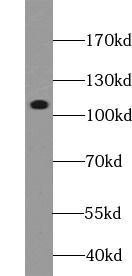Products
CYLD antibody
| Synonyms: | Ubiquitin carboxyl-terminal hydrolase CYLD|Deubiquitinating enzyme CYLD|Ubiquitin thioesterase CYLD|Ubiquitin-specific-processing protease CYLD|CYLD|CYLD1|KIAA0849 antibody | ||
| Catalogue No.: | FNab02142 | Reactivity: | Human, Mouse, Rat |
| Host: | Rabbit | Tested Application: | ELISA, WB, IHC, IP |
| Clonality: | polyclonal | Isotype: | IgG |
| Size | Price |
|---|---|
| 100µg | Inquiry |
- SPECIFICATIONS
- FIGURES
- CONDITIONS
- FAQS
- Product Name
- CYLD antibody
- Catalogue No.
- FNab02142
- Size
- 100μg
- Form
- liquid
- Purification
- Immunogen affinity purified
- Purity
- ≥95% as determined by SDS-PAGE
- Clonality
- polyclonal
- Isotype
- IgG
- Storage
- PBS with 0.02% sodium azide and 50% glycerol pH 7.3, -20℃ for 12 months(Avoid repeated freeze / thaw cycles.)
- Immunogen
- cylindromatosis(turban tumor syndrome)
- Alternative Names
- Ubiquitin carboxyl-terminal hydrolase CYLD|Deubiquitinating enzyme CYLD|Ubiquitin thioesterase CYLD|Ubiquitin-specific-processing protease CYLD|CYLD|CYLD1|KIAA0849 antibody
- UniProt ID
- Q9NQC7
- Observed MW
- 110 kDa
- Tested Applications
- ELISA, WB, IHC, IP
- Recommended dilution
- WB: 1:500-1:1000; IP: 1:200-1:1000; IHC: 1:50-1:500
 A431 cells were subjected to SDS PAGE followed by western blot with FNab02142(CYLD antibody) at dilution of 1:500
A431 cells were subjected to SDS PAGE followed by western blot with FNab02142(CYLD antibody) at dilution of 1:500
 IP Result of anti-CYLD (IP: FNab02142, 4ug; Detection: FNab02142 1:300) with mouse brain tissue lysate 4000ug.
IP Result of anti-CYLD (IP: FNab02142, 4ug; Detection: FNab02142 1:300) with mouse brain tissue lysate 4000ug.
 Immunohistochemistry of paraffin-embedded human colon cancer using FNab02142(CYLD antibody) at dilution of 1:50
Immunohistochemistry of paraffin-embedded human colon cancer using FNab02142(CYLD antibody) at dilution of 1:50
- Background
- Protease that specifically cleaves 'Lys-63'-linked polyubiquitin chains. Has endodeubiquitinase activity. Plays an important role in the regulation of pathways leading to NF-kappa-B activation(PubMed:12917689, PubMed:12917691). Contributes to the regulation of cell survival, proliferation and differentiation via its effects on NF-kappa-B activation(PubMed:12917690). Negative regulator of Wnt signaling(PubMed:20227366). Inhibits HDAC6 and thereby promotes acetylation of alpha-tubulin and stabilization of microtubules(PubMed:19893491). Plays a role in the regulation of microtubule dynamics, and thereby contributes to the regulation of cell proliferation, cell polarization, cell migration, and angiogenesis(PubMed:18222923, PubMed:20194890). Required for normal cell cycle progress and normal cytokinesis(PubMed:17495026, PubMed:19893491). Inhibits nuclear translocation of NF-kappa-B. Plays a role in the regulation of inflammation and the innate immune response, via its effects on NF-kappa-B activation(PubMed:18636086). Dispensable for the maturation of intrathymic natural killer cells, but required for the continued survival of immature natural killer cells. Negatively regulates TNFRSF11A signaling and osteoclastogenesis(By similarity). Involved in the regulation of ciliogenesis, allowing ciliary basal bodies to migrate and dock to the plasma membrane; this process does not depend on NF-kappa-B activation(By similarity).
How many times can antibodies be recycled?
First, usually it's not suggested to recycle antibodies. After use, buffer system of antibodies has changed. The storage condition of recycled antibodies for different customers also varies. Thus, the performance efficiency of recycled antibodies can’t be guaranteed. Besides, FineTest ever conducted the antibody recycling assay. Assay results show recycling times of different antibodies also varies. Usually, higher antibody titer allows more repeated use. Customers can determine based on experimental requirements.
Notes: After incubation, we recycle rest antibodies to centrifuge tube and store at 4℃. High titer antibodies can be stored for a minimum of one week. Reuse about three times.
What are components of FineTest antibody buffer?
Components of FineTest antibody buffer are usually PBS with proclin300 or sodium azide, BSA, 50% glycerol. Common preservative is proclin300 or sodium azide, which is widely applied in the lab and industry.
How about the storage temperature and duration of FineTest antibodies?
Most antibodies are stored at -20℃. Directly-labeled flow cytometry antibodies should be stored at 2 - 8℃. The shelf life is one year. If after sales issues for purchased antibodies appear, return or replacement is available. Usually, antibodies can be still used after the one-year warranty. We can offer technical support services.
Is dilution required for FineTest antibodies? What’s the dilute solution?
Directly-labeled flow cytometry antibodies are ready-to-use without dilution. Other antibodies are usually concentrated. Follow the dilution ratio suggested in the manual. Dilute solution for different experiments also varies. Common antibody dilution buffers are acceptable(e.g. PBST, TBST, antibody blocking buffer).
How to retrieve antibodies for immunohistochemistry?
Common retrieval buffers: Tris-EDTA Buffer(pH 9.0); Citrate Buffer(pH 6.0)
Heat induced antibody retrieval:
Method 1: Water-bath heating: Put the beaker with retrieval buffer and slide in the boiling water bath. Keep the boiling state for 15min. Naturally cool to room temperature;
Method 2: Microwave retrieval: Put the beaker with retrieval buffer and slide in the microwave oven. Heat at high power for 5min, Switch OFF for 3min, Heat at medium power for 5min. Naturally cool to room temperature.
How to choose secondary antibodies?
(1) Secondary antibodies react with primary antibodies. Thus, secondary antibodies should be against host species of primary antibodies. E.g. If the primary antibody is derived from rabbit, the relevant secondary antibody should be against rabbit. E.g. goat anti rabbit or donkey anti rabbit.
(2) Choose secondary antibody conjugates according to the experimental type, e.g. ELISA, WB, IHC etc. Common enzyme conjugated secondary antibodies are labelled by HRP, AP etc. Fluorescin or dye labelled secondary antibodies are applied in immunofluorescence and flow cytometry(e.g. FITC, Cy3).
